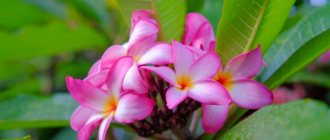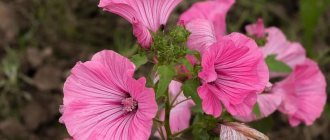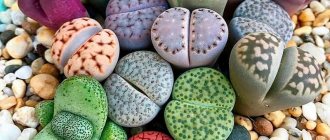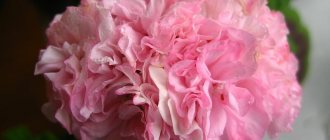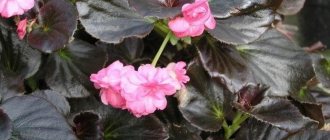They really look like pebbles, which sometimes “crack” and produce either beautiful flowers of the original appearance or new leaves. The lithops flower is considered the most compact indoor plant: each “pebble,” which actually consists of two fused leaf plates of a peculiar shape, reaches a size of up to 5 cm.
Flower growers and collectors value lithops not only for their shape, but also for their interesting colors: they come in green, grayish, bluish, pink, brownish and other shades. A pattern of specks of different sizes and shapes is usually clearly visible on the surface of the leaves. The Lithops flower appears on a short peduncle and can be white, yellow or orange, up to 3 cm in size. In some types of Lithops, the flowers are not only beautiful, but also have a pleasant smell. Flowering in Lithops begins at 3–4 years of age.
The characteristic appearance of Lithops is a consequence of very difficult natural conditions in their habitats: these are hot, arid deserts with sandy or rocky soil, where long dry seasons alternate with periods of rain. In such circumstances, plants have to solve the problem of retaining moisture for a long time and minimizing its loss through the surface of the leaves. And camouflage “like a stone” is a way to protect yourself from being eaten by animals.
It is believed that lithops are sometimes able to change their color and pattern so as to blend in as closely as possible with the background in which they grow (1).
Description
Lithops belongs to the Aizaceae family. They are divided into types and subspecies according to size, color and colors. Although it can be difficult to determine whether they belong to a specific species. Lithops can change color to adapt to their environment. Botanists have identified 37 types of “living stones,” but about ten popular species are grown at home.
This is what Lithops looks like in its natural habitat
The rocky desert of South Africa is considered the birthplace of Lithops. They are also found in the Southwestern part of the African continent. Rocky slopes covered with granite chips, areas with clay soil - this is where you can find “living stones”. Sometimes they blend in color with the surrounding stones, hiding half among the stone scatterings from the heat.
Lithops have good survival rate. They grow even where there are no other plants. During the day they can withstand fifty-degree heat, followed by cold nights. After all, in deserts there is a big difference between day and night temperatures.
Lithops structure
Externally similar to pebbles, the plants consist of pairs of fleshy leaves that do not have a stem. They are attached to the root, merging at the base. Thick leaves store moisture to survive dry periods. The leaves are separated by a hollow slit, in which light green meristem cells are visible. Flowers and new leaves emerge from it. The leaves themselves have a gray-green, purple or brown tint on the side. And from above you can see lighter leaf windows through which the plant exchanges gases and receives sunlight. Under natural conditions, only the upper part of the plant with leaf windows is visible among the stones and sand.
Important! Lithops tissues contain toxic substances that can be harmful if ingested by children and pets.
Flowers appear from the hollow, and their diameter exceeds the size of the leaves. The flowers are usually white or yellow. In this case, the yellow color varies from bright yellow to light yellow.
Lithops are perennial plants, but they annually replace old leaves with new ones.
Interesting Facts
Lithops were first discovered in the 19th century by the English botanist Burcello. These succulents can live up to 100 years. Growing in the desert, during periods of drought, lithops “burrow” into the sand, hiding from intense ultraviolet rays. This happens thanks to the root system, which contracts and pulls the plant into the soil.
Due to their exotic appearance and original flowering, lithops can decorate any interior. The main thing is to provide the succulent with timely and proper care.
READ ABOUT OTHER SUCCULENTS: GASTERIA, COTYLEDON, GRASSWORTH, JUNILOUS, SEDUM, a href=”https://botanicoved.com/komnatnye/sukkulenty/raznovidnosti-sukkulenty/pahifitum.html” rel=”noopener” target=”_blank”> PACHYPHYTUUM, PORTULACARIA, SEDEVERIA, STAPELIA, HAWORTIA, EONIUM, ECHEVERIA.
Varieties
If about forty species grow in natural conditions, then in indoor floriculture a dozen to one and a half popular species and hybrids are grown. Let's look at the most famous varieties of “living stones”.
Aucamp
The leaves have a rounded upper part, reaching four centimeters in width. The main color is green, but there are varieties of gray-blue color. And there are brown spots scattered on the top. The gap between the leaves is deep. The flowers are large and yellow.
Leslie
It is distinguished by its small size - the diameter of the upper part is from 1 to 2 cm. Colors: gray; brown with a pink tint; coffee with milk; reddish green. The upper part is covered with marble stains of a darker color. The size of the flowers exceeds the diameter of the leaves, reaching five centimeters. Yellow or white flowers emit a light scent.
Most suitable for beginner gardeners, as it tolerates errors in watering more easily than other types.
Marble
The gray leaves expand upward, reaching two centimeters in diameter. The upper part is covered with a marble pattern, which gives the species its name. Flowers are white, 5 cm in diameter.
Olive green
The olive green color of the leaves at the top is complemented by spots. Plant dimensions: height – 2 cm, width – 1.5-2 cm. It is distinguished by a small depth of the gap between the leaves, not exceeding 5 mm. Flowers are yellow.
This may be interesting: Euphorbia (Euphorbia) - care tips
Optics
The leaf size is 2 cm. The color of the leaves ranges from light green to gray-green. There is a subspecies with purple leaves. The leaves are separated by a deep cleft. Flowers are white.
Beautiful
Size: height - up to 3 cm, and diameter - up to 2.5 cm. It is distinguished by a deep cleft between the leaves. The leaves are yellow-brown, covered with dark sinuous lines at the top. The flowers are white, with a pleasant scent.
Pin-shaped
The red-brown fleshy leaves are about 2.5 cm in diameter. The top of the plant is flattened, covered with dark brown grooves and papillae, which makes the surface rough. The yellow-orange flowers reach four centimeters in diameter.
Divided
The leaves measure 3 cm in height and about 2 cm in diameter. The leaves are separated by a deep gap, practically not merging with each other. The color of the leaves is green with the addition of gray. The upper part is beveled. The small flowers are yellow.
Soleros
The olive-colored leaves have the following dimensions: height – 3 cm, diameter – 2.5 cm. The crevice between the leaves is small. The flat top is covered with darker spots. White flowers grow up to four centimeters.
False truncated
Leaf dimensions: height – 4 cm, diameter – 3 cm. Color: brown, gray and pink. The flat top is covered with a thin pattern of a darker shade. The gap between the leaves is narrow and deep. The flowers are golden yellow and reach 4 cm.
Bloom
The flowering period of lithops depends on the species and conditions during the resting phase. Usually at the end of summer a bud appears in the crevice between the leaves. The daisy-like flowers bloom when it is spring in the Southern Hemisphere, but here we are in late August, early or mid-autumn.
In almost all photos, lithops have flowers whose corolla diameter is larger than the size of the leaves. In reality, a lot depends on the conditions that will be created for the plant indoors.
Varieties with snow-white, golden-yellow, orange, reddish and purple petals are found in indoor culture.
Rules of care
Despite the unpretentiousness and ease of care when growing lithops, it is necessary to take into account some plant characteristics. First, let's look at the basic requirements, and then focus on the intricacies of care.
Lighting
Coming from hot Africa, “living stones” need a lot of light. Therefore, they are placed on southern and southeastern windows. In summer, if necessary, shade the plants from the midday sun with a light curtain. This precaution is necessary for some types of lithops. They also shade those flowers that experienced a lack of light in winter.
In winter, plants need constant additional lighting. Typically LED and fluorescent lamps are used. Place the lamps at the following distance from the plants:
- for adults - 10 cm;
- for seedlings - 5-7 cm.
Also, after winter, lithops are gradually accustomed to the sun. In the absence of the required amount of light in winter, “living stones” begin to stretch and may die.
Temperature
From the beginning of spring until autumn, lithops grow well at room temperature from 22 to 25 degrees. During hot summers, plant roots can overheat in pots because long roots naturally extend to depths where the temperature is lower than at the surface. In small pots, especially plastic ones, the roots experience overheating. To avoid overheating, it is recommended to use ceramic pots and plant “living stones” in large containers along with other succulents and groups of several lithops.
In winter, plants must be provided with a cool winter at a temperature of 12 to 15 degrees. The air temperature should not be allowed to drop below eight degrees.
Watering
Lithops do not require frequent watering. Excess moisture leads to rotting of the roots and death of the plant. Basic rule:
- during the growing season, water twice a month;
- In winter, watering is stopped.
When watering, do not allow water to get on the leaves, especially in the crevice between them. Watering from a tray requires the ability to determine the required amount of water. Otherwise, the soil in the pot may absorb too much or too little liquid.
"Living stones" develop according to a special schedule, different from other plants. Therefore, the general rule of watering requires adjustment depending on the development cycle.
Lithops development phases
| Phase | Duration | Features of development | Watering |
| 1 – rest period. | From early summer to mid-August. | In nature, lithops stop growing with the onset of a hot period, using accumulated moisture reserves. | Watering is stopped. If wrinkling of the leaves is observed, then water with a small amount to moisten to a depth of about one centimeter. With the onset of August, you can spray a little with a fine spray. Water should not get into the gap between the leaves, and the leaves themselves should dry out within half an hour. |
| 2 – period of flowering and formation of new leaves. | From mid-August to early winter. | Lithops produce buds and flowering begins. After the flowers fall, new leaves appear from the gap between the leaves. Old leaves give up moisture to young ones, gradually shrinking and drying out. | Gradually increase watering. During this period, watering should be rare but plentiful. After watering, the soil should dry completely. So water until the end of the flowering period. Then watering is gradually reduced so that the plant enters the winter period. |
| 3 – period of slow growth. | Winter months. | New leaves continue to grow in cool winter conditions. Good lighting must be provided. | Watering stops. You can't even spray it. |
| 4 – replacing old leaves with new ones. | Spring months. | New leaves replace old ones, which gradually become thin. Old leaves can be removed after complete wilting. | They begin to increase watering, bringing it to normal (once every two weeks) with complete drying of the soil. In May, watering is reduced to stop completely with the onset of summer. |
Important! When growing lithops, the main attention is paid to the actual development cycle.
Depending on the species and the conditions under which the plant is kept during the winter months, the phases may shift in time in one direction or another. Therefore, the need for watering is determined by the stage of development: buds, flowering or the formation of new leaves. This is the main difficulty in growing lithops. Beginning flower growers will only be able to obtain a beautiful flowering plant through experience, carefully observing the condition of the “living stones”.
How and when to replant lithops
To transplant and plant lithops, you need to prepare pots of the required size and soil mixture. Considering that the roots grow deep, the height of the pot should be such that the roots are spread out along their length, taking into account drainage. At the bottom it is necessary to put a layer of drainage made of expanded clay or crushed bricks.
The soil must be prepared lightly so that water does not stagnate in it. When preparing it yourself, use the following components:
- leaf or turf soil - 1 part;
- coarse sand - 1 part.
Sand can be replaced with gravel chips 1-2 mm in size. You need to add one part of gravel chips to the finished mixture for cacti. Be sure to warm the soil in the oven for half an hour.
A flower purchased at the market or in a store must be immediately replanted in new soil. After all, plants sold are often planted in nutritious peat soil to accelerate development. And this in the future can lead to the death of lithops, because such soil does not allow water and air to pass through well. Before transplanting, water the plant a little to make it easier to remove old soil. Clean the roots carefully using a regular wooden toothpick. But after planting, you can’t water it for several days.
It is recommended to pay attention to the correct fit. The root is straightened along its entire length, avoiding bends and creases. The soil is added gradually, without compacting. The root collar should not be covered with soil. For stability and to ensure greater permeability to water, small pebbles about five millimeters in size are placed on the ground.
Plants are replanted as needed when they become cramped in an old pot.
Recommendation! Lithops grow best if they are planted in one pot in groups, at a distance of two centimeters from each other. You can plant “living stones” along with other plants that do not require frequent watering. This makes it easier to maintain water and temperature conditions in the pot.
Top dressing
Lithops do not really need feeding. Therefore, there is a rule for them:
- If the plant is replanted every year, then the reserves of nutrients in the soil are sufficient for them.
- If replanting was not carried out, then in the second year they are fed once a month in the summer. They use cactus fertilizer, but take half the recommended dose.
Transfer
It is recommended to purchase lithops only during the growing season. After purchase, they should be immediately replanted in suitable soil.
Before planting, the root system is freed from peat, dried and checked for damage. A prerequisite is the presence of a drainage layer at the bottom of the pot. After that, just lay the soil, pour boiling water over it, transfer the flower and water it. The pot should be no more than 10 cm.
Lithops do not need frequent transplantation. Adult plants are replanted every 3–4 years, and young plants every 2 years. The process is carried out after wintering. The pot should be 1 cm higher than the previous one, or it can be moved to an old flowerpot with new soil. You will find all the subtleties and nuances of planting and replanting this original plant in a separate article.
Reproduction of Lithops
Lithops differ from other indoor plants in that at home they are grown only from seeds. Seeds can be purchased at flower shops or grown yourself. To do this, you need to have two plants flowering at the same time. Lithops begin to bloom after three years of cultivation. A brush is used to transfer pollen from one flower to another. The seeds ripen within nine months. Small seeds are located in the fruit-box.
Seeds remain viable for a long time if stored in a cool, dry place. Before sowing, they must be cleared of husks and fruit residues. Fresh fruits are peeled by hand and then sifted through a fine sieve. Dry seeds are pre-soaked in water to make it easier to remove the capsule. Seeds in a cup of water fall to the bottom, and the pulp and husk float to the surface. They are carefully collected. The seeds are placed on a napkin and dried.
The best time for sowing is the summer months. Sowing can be done at any time of the year, provided good lighting and temperature conditions are provided.
Soil for lithops seeds can be prepared with your own hands in the following ratio:
- coarse sand - 50%;
- clay-turf soil - 30%;
- granite chips, fine gravel, perlite - 20%.
Sowing containers are filled with soil and compacted. The seeds are sifted through a fine sieve onto the soil and sprinkled with a thin layer of coarse sand. Lightly moisten the top with a spray bottle and cover with glass and film. The film is removed daily for ventilation. The pot with seeds is placed in a warm place, maintaining a temperature of 20-28 degrees. For better ventilation, the film is replaced with gauze after a few days.
The best place to grow lithops from seeds is to place the container in an aquarium. By covering the aquarium with gauze, you can provide access to fresh air and the necessary humidity. The seeds germinate in a couple of weeks. The seedlings are watered with warm, settled water. As the seedlings grow, watering is reduced. It is not recommended to replant seedlings in the first year. If the seedlings elongate strongly, the sand layer is increased.
Temperature
In summer, the plant can be kept at temperatures from 20 to 30°C. The plant tolerates higher temperatures well. It can also be kept outdoors.
In winter, the succulent needs a cold wintering . The temperature in winter can be reduced to 10-12°C and even to 8°C.
Being natives of deserts, where heat often gives way to cold, Lithops tolerate temperature fluctuations well. However, you should not experiment with strong changes or lower the temperature in winter below 5 degrees.
At higher temperatures in the cold season, lithops stretch out, losing their decorative appearance. Keeping it too hot in winter can also cause a lack of flowering.
Being in the fresh air during the warm season hardens plants, makes them stronger, healthier and stronger, and promotes flowering.
Diseases and pests
With excessive moisture, lithops suffer from root rot. Other problems associated with improper watering include:
- new leaves appear before the old ones dry out;
- leaves swell and burst;
- root rotting, brown spots on leaves.
With a lack of light, the pattern on the upper part of the leaves turns pale, and the leaves themselves become elongated.
Why don't lithops bloom? If, after three years of age, the “living stones” have not bloomed, this may be due to the following violations of the regime:
- insufficient lighting;
- the watering regime is disrupted;
- excess fertilizer;
- the regime during the rest period is disrupted.
Lithops pests
Like other plants, lithops are sometimes affected by pests, which most often come from neighboring flowers.
- When affected by mealybug, the leaves of Lithops become covered with a whitish coating. You can wash the leaves with soapy water. If necessary, treat with Actellik.
- A white coating appears on the walls of the pot when a root mealybug appears. It is necessary to remove the plant; a gray coating is visible on the roots. The roots are washed with hot water (50 degrees), the roots and leaves are treated with Aktara. Plant in a new pot with sterilized soil.
- Sciarides, or fungus gnats, attack the roots, which can lead to the death of the plant. To remove flying adult insects, you can use Raptor. The soil is treated with insecticides “Mukhoed” and others.
- To combat aphids, you can use folk remedies: soapy water (laundry soap), tobacco infusion. If there is no result, insecticides are used.
Possible problems
It happens that inexperienced gardeners complain about the problem of a succulent. Meanwhile, if you properly care for the plant, problems can be avoided. Let's look at the most common violations and their causes:
- new leaves are smaller than the previous ones - a failure in the process of changing old leaves;
- the leaves are wrinkled - not enough watering during the dormant period, or an attack by spider mites;
- the roots began to rot - the consequences of being in a wet peat soil mixture;
- the leaves have swollen and begun to burst - the succulent is over-watered;
- “rusty” spots on the sheets – improper watering;
- patterns on the leaves turn pale - lack of sun;
- does not bloom - too much fertilizer or improper conditions for keeping lithops during wintering;
- Shoots do not appear when propagated by seeds - the seeds are waterlogged or planted too deeply;
- the seedlings are stretched out - there is not enough light;
- green deposits on the soil - waterlogging, inadequate drainage.
If you do not water your lithops correctly, your plant may be attacked by wet rot. The plant begins to wither before our eyes, the leaves lose their elasticity, become thinner, and emit a sharp, repulsive odor. The rotting cannot be stopped. The only thing you can do is remove the affected areas with a perfectly sharpened knife, buy a new pot, and replace the soil mixture.
Before buying lithops, study the description of the species, look at the photo and choose the most suitable plant. You might be interested in the idea of creating a lithops mix by placing several varieties in one succulent garden. This is not only beautiful, but also convenient, because regardless of the variety, living stones are grown the same way.
Watering
Lithops is watered very rarely, but abundantly. The pot with the plant is immersed in water, and after 20 minutes it is removed and the water is allowed to drain.
The “living stone” is watered monthly from May to September, a total of 5 times a year . In the autumn-winter period it is not watered at all.
This succulent is never sprayed. Spraying is absolutely unnecessary and very harmful to “living stone”.
Water should not be allowed to get between the leaves of the lithops: this can lead to rotting.
Priming
For lithops, store-bought soil for succulents or other universal soil that does not contain peat is suitable. You can also prepare the soil mixture yourself. It should be light and water-permeable.
To do this, mix turf soil with coarse sand in equal proportions. Another substrate option is sheet soil, brick chips, sand, clay and coal (2: 2: 4: 1: 1).
The resulting mixture is calcined in the oven for at least 30 minutes.
General information
The plant is a perennial succulent. Its root system is very developed and exceeds the size of the ground part of the flower. This is due to the fact that in nature the flower has to cling tightly to rocks and scattered stones.
Above the soil are two thick small leaves. They have a hard, dense structure. The appearance resembles a stone. Since in the desert any green plant runs the risk of being quickly eaten, such forms help the succulent camouflage itself. From a distance they fit quite well onto pebbles.
The fleshy leaves grow up to 5 cm in height. They are divided across by a depression line and slightly separated on the sides. The main colors are gray, lilac, brown, gray-green. The color of the leaves sometimes has a slight relief pattern of winding lines.
In August, the distance between the two halves begins to increase slightly. A flower is formed, which in appearance and structure resembles the buds of cacti. The color is usually white, yellow or pink. Flowering duration is up to 14 days. When the flower opens, it is often larger than the leaves themselves.
Species diversity
The genus Lithops is extremely diverse in size, shape and color of leaves. They can reach up to 5 centimeters in width and height, are flat or convex, have a solid color or decoration in the form of a pattern, specks, or colored spots.
Specific epithets for lithops are assigned according to several criteria:
- plant characteristics: beautiful, finely lined, warty, eye-shaped, olive green, splayed, red-headed, marbled, divided;
- name of the area in which it grows: salt-growing, Mariental, Karas, Hermetic (found in the closed area of the Spergebit diamond mines).
- name of a botanist: lithops of Meyer, Lestle, Aucamp, Dinter, Geyer, Franz, Werner.
In a city apartment, a south or south-east window is ideal for growing exotic plants. Knowing the characteristics of lithops and following the rules of care, you can collect an extensive collection of these amazing succulents.

